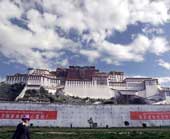|
|
India-China relations have moved forward a long way since Atal Bihari Vajpayee first journeyed to China in February 1979, as foreign minister in Morarji Desai’s cabinet. A comparison of the results of his recent visit and the outcome of his earlier trip throws into relief the transformation that has occurred in the intervening quarter century in our bilateral relations as well as in the global political environment.
Vajpayee’s recent trip was undoubtedly productive in terms of speeding up progress in bilateral relations. It is expected to remove a major irritant in India-China ties. Under a border trade agreement concluded during the Vajpayee visit, it was agreed to conduct trade through the Nathu La by establishing markets at Changu in Sikkim and Renqinggan in Tibet. The accord implies de facto recognition by China of Sikkim’s position in India and the Chinese are expected to take steps in due course to convey de jure recognition. These steps will strengthen the mutual trust and confidence on which good neighbourly relations are built.
The Chinese, on their part, attach particular importance to a sentence in the joint declaration reading: “The Indian side recognizes that the Tibet Autonomous Region is part of the territory of the People’s Republic of China and reiterates that it does not allow Tibetans to engage in anti-China political activities in India.” There has been some ill-informed criticism in India that this formulation is somehow a “concession” on our part. In fact, it is no more than a reiteration of our traditional position.
In the early Fifties we recognized Chinese sovereignty over Tibet. In the 1954 agreement, we acknowledged that the Tibet region (as it was then called) is a part of China. And after Beijing announced the establishment of the Autonomous Region of Tibet we have consistently stated that Tibet is an autonomous region of China. We have also repeatedly made it clear that the Tibetans residing in India will not be permitted to engage in hostile anti-China activities from Indian soil.
While most resident Tibetans are peaceful and law-abiding, there is a small number of trouble-makers who seek to disrupt India’s ties with our northern neighbour in various ways, especially by staging unlawful protests during visits of Chinese leaders. On such occasions, the Indian government has rightly taken action under the law to restrain these elements from causing disruption or acting against our policy of non-interference in the internal affairs of other countries.
While the Sikkim border trade agreement and the reiteration of India’s position on Tibet were the highlights of the visit, a number of other accords also deserve notice. Among these are the decisions to appoint special representatives to explore the framework of a boundary agreement, to hold annual meetings of the foreign ministers, to form a joint study group to draw up a five-year programme for expanding trade and economic cooperation, to increase cooperation at the World Trade Organization, and to set up cultural centres in Beijing and New Delhi. Taken together, this is indeed a good harvest.
Like his recent visit, Vajpayee’s earlier journey to China was also productive. It was one of the first milestones on the road to repairing India-China relations after the 1962 conflict. By 1970, India and China had sent out signals conveying a desire to repair relations. However, despite Mao’s famous smile and hand-shake with the Indian charge d’affaires, no progress was possible for several years. This was mainly because of a regional development whose impact was further magnified by the fact that it coincided with a maj- or strategic realignment at the global level. When the Bangladesh liberation struggle erupted in 1971, China sided with its Pakistan ally, throwing its full diplomatic weight against Bangladesh and India. At almost the same time, using Islamabad as an intermediary, Nixon and Kissinger were putting in place a new strategic partnership with China directed at the Soviet Union.
Anticipating an Islamabad-Beijing- Washington axis, India concluded a treaty of peace and friendship with the USSR. Anxious to cultivate his new Chinese ally, Kissinger went to the extent of secretly encouraging China to intervene militarily against India, but the latter would not be drawn into a dangerous adventure.
It was not until 1976 that the first concrete steps were taken to mend Sino-Indian ties. In that year, the two countries decided to restore diplomatic ties at the ambassadorial level. The next major step was Vajpayee’s visit to China in 1979 — the first ministerial-level visit between the two countries in over 16 years.
Vajpayee’s 1979 journey to China was not, however, an unmixed success. While the Indian foreign minister was still on Chinese soil, Beijing decided to “teach a lesson” to the Vietnamese by launching an armed excursion, and Deng Xiaoping added to India’s discomfiture by drawing a parallel with the attack against India in 1962. Vajpayee had to cut short his visit to China. Moreover, a reciprocal visit from the Chinese side was delayed by another regional development. India established diplomatic ties with the pro-Vietnamese Heng Samrin government in Cambodia, casting a new chill over India-China relations. It was not until June 1981 that the Chinese foreign minister, Huang Hua, travelled to India, reciprocating the Vajpayee visit.
The real breakthrough in India-China relations came with Rajiv Gandhi’s visit to China in 1988 — the first prime ministerial visit between the two countries since Zhou Enlai came to India in 1960. Concrete steps were taken during this visit to promote all-round bilateral cooperation while the two parties sought a peaceful solution to the border issue. Thus, a working group was formed to promote trade and investment, and agreements were signed for cooperation in such fields as culture, civil aviation and science and technology. A joint working group was set up for negotiations on the boundary issue and for exploring ways and means of maintaining peace and tranquillity along the Line of Actual Control pending a resolution of the border issue.
Since 1988, India-China ties have shown steady improvement. The border areas have remained tension-free, military ties have been established and trade has risen from a negligible figure to an impressive 5 billion dollars last year. This is expected to rise to $ 10 billion by 2005. China has moved away from its earlier policy of siding with Pakistan on Kashmir and other Indo-Pakistani issues. It now calls upon India and Pakistan to resolve these issues through peaceful consultations. The boundary issue is yet to be resolv- ed, but there can be no doubt that the marked improvement that has taken place in the climate of relations will facilitate an eventual resolution.
The progress achieved in recent years reflects sensible management of bilateral relations by the two countries. At the same time, progress has been facilitated by two global developments. First, the integration of the Chinese and Indian economies with the global economy has opened up vast markets for each of these countries in the other. These new economic ties are helping to create a positive climate of opinion in each country about the other.
Second, the end of the Cold War made it easier to accelerate the improvement of bilateral ties. As we saw earlier, during the last phase of the Cold War, regional developments in south and southeast Asia were viewed in China through the lens of the Sino-Soviet conflict, and developments in Bangladesh, Cambodia or Vietnam could hold up progress in India-China relations. This obstacle has ceased to exist. India and China can now concentrate their efforts on strengthening bilateral ties without having to grapple with the fall-out of a Cold War.











